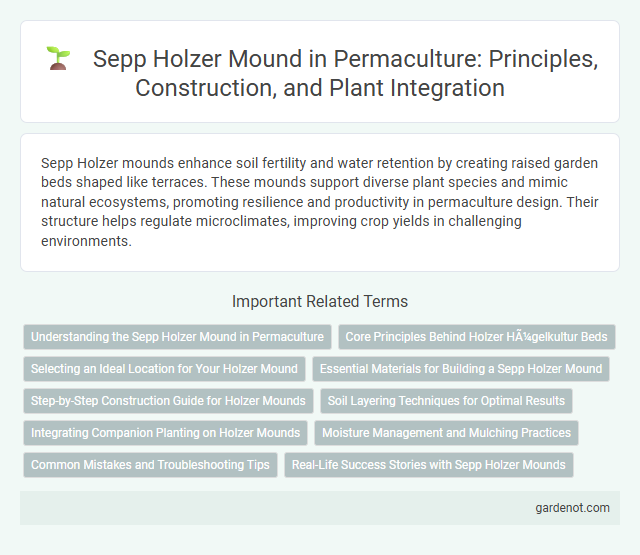Sepp Holzer mounds enhance soil fertility and water retention by creating raised garden beds shaped like terraces. These mounds support diverse plant species and mimic natural ecosystems, promoting resilience and productivity in permaculture design. Their structure helps regulate microclimates, improving crop yields in challenging environments.
Understanding the Sepp Holzer Mound in Permaculture
The Sepp Holzer mound is an innovative permaculture technique designed to enhance microclimates, water retention, and soil fertility through strategically shaped earthworks combined with diverse plant species. This structure mimics natural landforms, creating varied moisture and temperature zones that support resilient ecosystems and increase agricultural productivity. By integrating layered vegetation and water management systems, the Sepp Holzer mound exemplifies sustainable land use and regenerative farming principles.
Core Principles Behind Holzer Hügelkultur Beds
Sepp Holzer's Hugelkultur beds are designed around core principles of natural soil regeneration, water retention, and biodiversity enhancement. These mounds incorporate layers of wood, compost, and soil that decompose slowly, fostering nutrient cycling and improved soil structure. The design optimizes microclimates and supports resilient plant growth by mimicking natural forest ecosystems.
Selecting an Ideal Location for Your Holzer Mound
Choosing the ideal location for a Sepp Holzer mound requires analyzing soil quality, sunlight exposure, and water drainage patterns to promote optimal plant growth and microclimate creation. Positioning the mound on a gentle slope with well-drained soil enhances natural irrigation through gravity, while ensuring sufficient sunlight supports diverse crop cultivation. Proximity to water sources and integration within existing permaculture zones maximizes ecosystem benefits and resource efficiency.
Essential Materials for Building a Sepp Holzer Mound
Essential materials for building a Sepp Holzer mound include a combination of soil types such as clay, sand, and organic compost to ensure optimal water retention and nutrient availability. Stones and rocks are strategically placed to create thermal mass, regulating temperature and supporting plant growth. Wood, branches, and mulch are incorporated to promote biodiversity and maintain soil moisture within the mound structure.
Step-by-Step Construction Guide for Holzer Mounds
Sepp Holzer mounds are designed to create microclimates that support diverse plant species by mimicking natural landscapes. Construction begins with selecting a suitable site, followed by shaping raised earth mounds integrated with terraces and swales to optimize water retention and erosion control. Incorporating layered vegetation, including deep-rooted plants, shrubs, and ground cover, enhances soil fertility and biodiversity within the Holzer mounds.
Soil Layering Techniques for Optimal Results
Sepp Holzer mound design employs advanced soil layering techniques that enhance water retention and nutrient cycling, vital for sustainable permaculture. Layers typically include a base of stones for drainage, followed by organic material like compost and mulch that foster microbial activity and root growth. This method creates a self-sustaining micro-ecosystem promoting plant health and resilience in diverse climates.
Integrating Companion Planting on Holzer Mounds
Sepp Holzer mounds offer a dynamic microclimate that enhances the effectiveness of companion planting by creating diverse root zones, moisture retention areas, and varied sunlight exposure. Integrating nitrogen-fixing plants, pest-repellent herbs, and nutrient accumulators like comfrey into Holzer mounds supports soil fertility, reduces pests, and promotes resilient polycultures. This synergy maximizes biodiversity and yields while mimicking natural ecosystems within permaculture design.
Moisture Management and Mulching Practices
Sepp Holzer mounds are designed to optimize moisture retention through strategic earth shaping that channels water toward plant roots, enhancing soil hydration during dry periods. Mulching practices on these mounds use organic materials like straw, leaves, and compost to reduce evaporation, regulate soil temperature, and promote beneficial microbial activity. This integrated approach to moisture management supports resilient plant growth and sustainable water conservation in permaculture systems.
Common Mistakes and Troubleshooting Tips
Sepp Holzer mounds often face common mistakes such as poor soil compaction, inadequate water retention, and improper plant selection for the microclimate. Troubleshooting tips include layering organic matter to improve soil fertility, creating swales or berms for effective water management, and choosing native or adaptive plants that thrive in local conditions. Regular monitoring and adjusting mound height or contour can prevent erosion and enhance overall ecosystem balance.
Real-Life Success Stories with Sepp Holzer Mounds
Sepp Holzer mounds transform challenging terrains into thriving ecosystems by optimizing water retention and promoting biodiversity, demonstrated in Holzer's alpine farm in Austria where arid slopes became fertile land. These earthworks support microclimates that enhance perennial plant growth and soil health, leading to increased crop yields and sustainability. Real-life success stories highlight how integrating Sepp Holzer mounds into permaculture designs regenerates degraded landscapes and fosters resilient food systems globally.
Sepp Holzer mound Infographic

 gardenot.com
gardenot.com